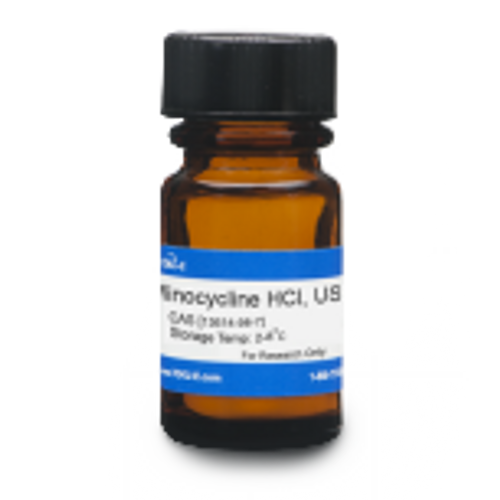Minocycline is a broad-spectrum, second-generation tetracycline. Like other tetracyclines, Minocycline shows broad spectrum antibacterial and antiprotozoan activity. It was patented in 1961 (American cyanamid) and synthesized in 1966 (Lederle Labs). Minocycline has been found to have many non-antibiotic biological effects in experimental models with inflammatory basis, autoimmune properties, and neuroprotection. It is an indirect inhibitor of inducible nitric oxide synthase. Minocycline is soluble in ethanol, methanol, DMF or DMSO but has limited water solubility.
We also offer:
- Minocycline Hydrochloride (M008)
| Mechanism of Action | Minocycline acts by binding to the 30S and 50S ribosomal sub-units, inhibiting the binding of aminoacyl-tRNA to the ribosomal acceptor (A) site thus blocking protein synthesis. It has many non-antibiotic effects, multiple mechanisms of action have been proposed. A better understanding of the in vivo activity is needed before its therapeutic potential can be accurately assessed. |
| Spectrum | Minocycline has broad-spectrum antibacterial activity and antiprotozoan activity. It has bacteriostatic activity against both Gram-positive and Gram-negative bacteria. It can also be used for methicillin-resistant Staphylococcus aureus (MRSA) and carbapenem-resistant Acinetobacter baumannii. |
| Microbiology Applications |
Minocycline is commonly used in clinical in vitro microbiological antimicrobial susceptibility tests (Etest, disk diffusion, and broth microdilution methods) against Gram-positive and Gram-negative microbial isolates. Medical microbiologists use AST results to recommend antibiotic treatment options. Representative MIC values include: Staphylococcus aureus (methicillin-resistant) 0.25 µg/mL - 8 µg/mL Pharmacokinetic/pharmacodynamic studies on Minocycline are scarce. A hollow-fibre in vitro model to simulate free-drug serum concentration with MRSA strains confimed that this agent is an AUC/MIC-driven agent. The estimation of MIC breakpoints is even more complex since tetracyclines including Minocycline have an atypical non-linear protein binding pattern. |
| Cancer Applications |
Minocycline inhibits in vitro invasion and experimental pulmonary metastatis in mouse renal adenocarcinoma (MRAC-PM2) cells (Masumori et al, 1994). It has been described to inhibit tumor growth in the xenograft tumor model of C6 glioma cells, inducing autophagic cell death. Its anti-proliferative activities increase its anti-tumor potential. |
| References |
Bishburg E and Bishburg K (2009) Minocycline--an old drug for a new century: Emphasis on methicillin-resistant Staphylococcus aureus (MRSA) and Acinetobacter baumannii. Int. J. Antimicrob. Agents. 34(5):395-401 PMID 19665876 Church RFR et al (1971) Synthesis of 7-dimethylamino-6-demethyl-6-deoxytetracycline (Minocycline) via 9-nitro-6-demethyl-6-deoxytetracycline. J. Org. Chem. 36:723 Fischer J, Ganellin CR (2006) Analogue-based Drug Discovery. John Wiley & Sons. p. 489 ISBN: 978-3-527-60749-5 Garrido-Mesa N, Zarzuelo A, Gálvez J. Minocycline: far beyond an antibiotic. Br J Pharmacol. 2013 May;169(2):337-52. doi: 10.1111/bph.12139. PMID: 23441623 Martel MJ and Boothe JH (1967) The 6-deoxytetracyclines. VII. Alkylated aminotetracyclines possessing unique antibacterial activity. J. Med. Chem. 10:44 Tsakris A, Koumaki V, Dokoumetzidis A (2019) Minocycline susceptibility breakpoints for Acinetobacter baumannii: Do we need to re-evaluate them? J. Antimicrob. Chemother. 74 (2):295-297 Wang P et al (2016) Comparison of Minocycline susceptibility testing methods for Carbapenem-resistant Acinetobacter baumannii. J Clin Microbiol. 54(12):2937-2941 |




